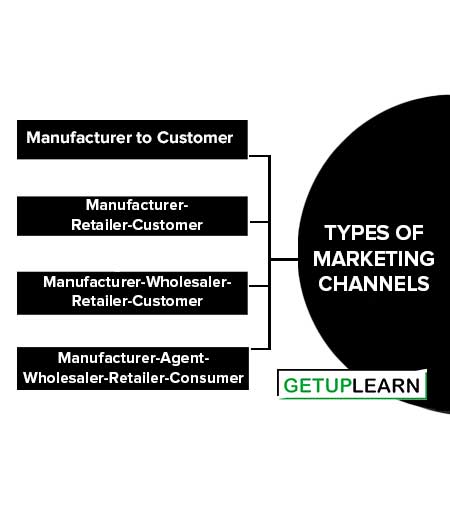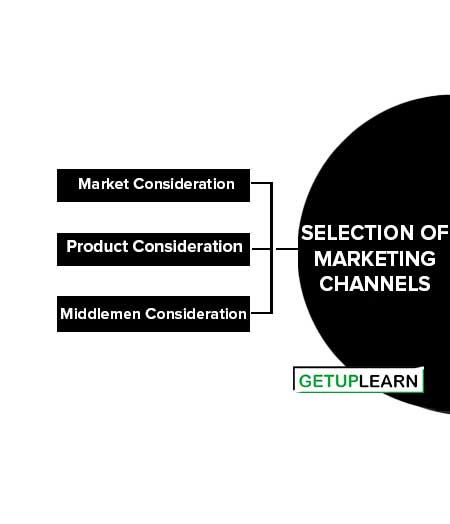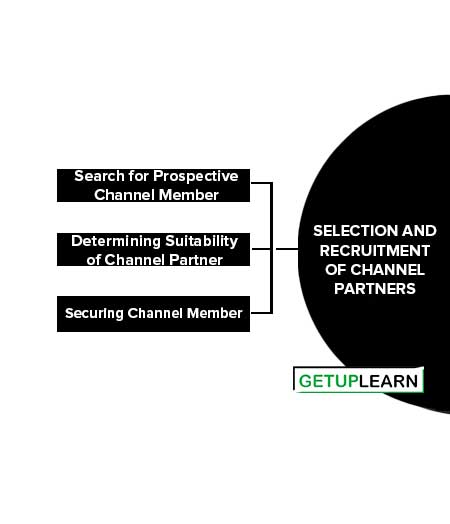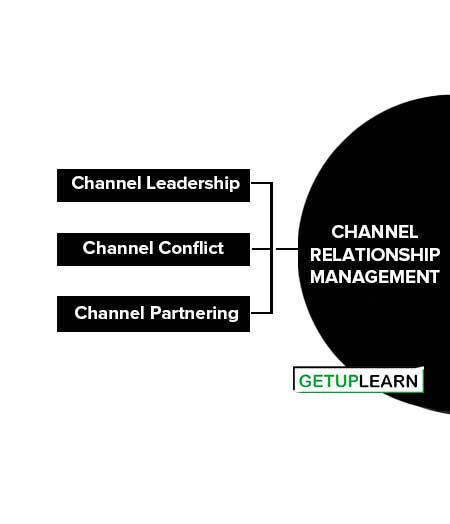Table of Contents
- 1 Meaning of Marketing Channels
- 2 Types of Marketing Channels
- 3 Selection of Marketing Channels
-
4 Designing Marketing Channels
- 4.1 Stage1 Identifying Need for Designing Channels
- 4.2 Stage2 Formulating Distribution Objectives
- 4.3 Stage 3 Specifying Distribution Task
- 4.4 Stage 4 Developing Possible Alternative Channel Structure
- 4.5 Stage 5 Evaluating Variables Affecting Channel Structure
- 4.6 Stage 6 Choosing Best Channel Structure
- 5 Selection and Recruitment of Channel Partners
- 6 Channel Relationship Management
- 7 FAQs About the Types of Marketing Channels
Meaning of Marketing Channels
Marketing channels are the ways through which goods and services get transferred from the point of production to the point of consumption. The goods and services pass through the marketing channels in order to reach the end consumers.
The marketing channels are the connecting point between producers and consumers. The channel partners like the distributors, wholesalers, and retailers take physical possession of the goods and stock them in order to make them reach the ultimate consumer. The marketing strategies regarding the channels influence the pricing, branding, offers, etc. of the business.
Types of Marketing Channels
There are four main types of marketing channels in the manufacturing:
- Manufacturer to Customer
- Manufacturer-Retailer-Customer
- Manufacturer-Wholesaler-Retailer-Customer
- Manufacturer-Agent-Wholesaler-Retailer-Consumer

Manufacturer to Customer
This is also known as zero level channel as there is no involvement of middlemen. In this type, the product flows directly from the manufacturer to the consumer. This is the simplest and the shortest marketing channel and as such it is very fast and economical.
It is mostly beneficial for small producers and producers of perishable commodities. But this marketing channel is also adopted by big companies for its cost-cutting benefit. Bata is a company that has adopted a Manufacturer to the Customer marketing channel.
Manufacturer-Retailer-Customer
This is also known as a One Level Marketing Channel. In this type, there is one stage of channel involvement between the producer and the customer. The producer sells to the retailer like departmental stores and they sell it to the ultimate consumer.
This marketing channel is mostly used for the distribution of consumer durables such as TV and refrigerators. The retailer purchases the goods from the manufacturer and performs marketing activities in order to sell the products to the consumer.
Manufacturer-Wholesaler-Retailer-Customer
This is also known as a two-level marketing channel. In this type, there are two middlemen namely the wholesaler and the retailer. This marketing channel is mostly used for products like groceries, cosmetics, etc. Since the goods pass through two stages, it may likely increase the price for the end consumer.
Manufacturer-Agent-Wholesaler-Retailer-Consumer
This is three level marketing channel. The producer instead of looking for a wholesaler sells the goods to an agent who takes the responsibility of searching for a wholesaler.
Selection of Marketing Channels
The selection of an appropriate channel of distribution is a crucial decision for every business. It’s important to compare the cost, sales volume, and profits expected from other alternative channels before deciding on the distribution channel. The selection of the right channel depends on a number of factors which are as follows:

Market Consideration
The nature of the market is an important factor that influences the selection of the marketing channel. The features of a market that are to be considered while making the selection of marketing channels are as follows:
-
Consumer or Industrial Market: If the product is of the industrial market the selection of a shorter channel is considered as the buyers of industrial products generally purchase in a huge quantity. Whereas in the case of consumer goods retailers are included.
-
Number and location of buyers: If the market of the product is small or buyers are limited smaller channels of marketing are considered easy and economical.
- Customer buying habits: The buying habits of customers like the desire for credit, the willingness of the customer to spend time while making the purchase decision, and the need for one-stop shopping influence the selection of marketing channels.
Product Consideration
The type and nature of the product also influence the selection of marketing channels. The features of a product that are considered important are:
-
Perishability: Products that are perishable in nature are generally sold through short channels as long channels might lead the products to deteriorate in quality. In addition to that, products where there are frequent changes in fashion also require shorter marketing channels.
-
Standardization: Products that are standardized in nature can be distributed through channels comprising middlemen but customized products demand direct contact between producer and consumer and hence shorter channels are preferred.
- Product Line: Businesses having a wide range of products might opt for their own retail outlet, whereas if a business deals with only one or two products it is more economical and convenient to sell through retailers.
Middlemen Consideration
There are a lot of factors in the cost and efficiency of middlemen that influence the decision regarding the selection of marketing channels. Some of the factors are:
-
Availability: The availability of the desired middlemen, who are willing to handle the products, is important.
-
Attitudes: The policies of the company and the attitude of the middlemen should match. Some retailers’ demand for a guarantee against price falls or sole selling rights has to match with the company’s marketing policies.
- Cost: The cost of middlemen is another important factor because companies need to estimate the final cost that the customers will have to pay for the product.
Designing Marketing Channels
The channel is basically a bridge between the manufacturer and the end customer. Designing channels involves decisions for the creation of new marketing channels or modification of existing channels.
Marketers while deciding on the most suitable channel consider a lot of factors such as product mix, marketing mix, width and depth of market, long-term commitments to channel partners, cost of the channel, company policies regarding services planned through the channel, and control over the channel by the company.
While designing channels it’s important to know the customer needs, channel objectives, cost, and the alternatives available before deciding the ideal channel system. The channel has to be profitable which means it should generate revenue for the company.
In addition to that it should also be suitable to carry on the smooth delivery of goods or services. The channel design has to be concerned with all the links in the process of the flow of products from the manufacturer to the end user. The organization while designing the channel system needs to understand the following questions:
- What are the activities needed to be performed by the channel (redistribution, stocking, collection and disbursements to the company)?
- Which activity will be performed by which channel member (C&F agents, distributors, wholesalers)?
- Describe the number of channel members needed for the number of C&F agents in the network.
- What are the services the channel members will need from the company (credit, infrastructure, lead time for placing order)?
- What are the services that the company will need from the channel members (number of outlets, frequency of coverage, etc.)?
- What is the compensation to be received by the channel members and how are their performances to be judged?
These are the stages in the development of designing marketing channels:
- Stage1 Identifying Need for Designing Channels
- Stage2 Formulating Distribution Objectives
- Stage 3 Specifying Distribution Task
- Stage 4 Developing Possible Alternative Channel Structure
- Stage 5 Evaluating Variables Affecting Channel Structure
- Stage 6 Choosing Best Channel Structure

Stage1 Identifying Need for Designing Channels
It is important for the company to identify the cause behind the decision to design a new channel. The need to design a new channel may arise due to various reasons like a new product or a new target market, environmental changes, new intermediary policies, etc.
Stage2 Formulating Distribution Objectives
While formulating the distribution objectives the first task is to be familiar with the general objectives and strategies of other marketing mix areas and that of the firm as a whole.
After that, the distribution objectives need to be set with the goal of achieving the overall marketing objective of the firm. After setting the distribution objectives it is important to check their compliance with the other marketing goals of the firm.
Stage 3 Specifying Distribution Task
The tasks that are required to be performed by the channel members need to be specified in order to meet the distribution objective. The main aim in specifying the distribution task should be easy and smooth delivery of goods or services to the end consumer.
Stage 4 Developing Possible Alternative Channel Structure
After specifying the distribution task the channel manager should focus on developing an alternative channel structure through which the objectives set can be met. The channel structure may be single or multiple depending on the need to reach the target market efficiently and effectively.
Stage 5 Evaluating Variables Affecting Channel Structure
There are various factors that affect the channel structure marketing variables (market size, market density, market behavior), product variables (product size, product weight, product perishability), company variables (financial capacity, managerial expertise, company objectives), intermediary variables (availability, cost, services offered), environmental variables ( economic, socio-cultural, technological, legal).
Stage 6 Choosing Best Channel Structure
It is the last stage where the best channel is selected depending on the performance required at the lowest possible cost. This is the most critical and crucial decision for the success of the channel design process.
Selection and Recruitment of Channel Partners
The selection of a channel is an important task for any company and it involves steps like identifying customer needs, checking on the availability of channel partners, and the fulfillment of the criteria set by the company. The selection of a channel partner generally consists of three steps:
- Search for Prospective Channel Member
- Determining Suitability of Channel Partner
- Securing Channel Member

Search for Prospective Channel Member
The search for prospective channel members is the first step in selecting the channel members. There are various sources that can help in the search for a suitable channel partner like the field sales force of the company.
The field sales force has knowledge about the potential channel members and can be a source for the company to find suitable and appropriate channel members. Various trade organizations can also provide insight regarding the prospective channel members for the company. The company can also advertise in order to find prospective channel members.
Determining Suitability of Channel Partner
Determining the suitability of the channel partner based on the fulfillment of selection criteria set by the company:
After the prospective channel members have been classified, the company now needs to apply the selection criteria and analyze the suitability of the channel partner based on those criteria. The company may have selection criteria related to the financial strength of channel partners, product-related knowledge, and so on.
Securing Channel Member
It is not only the manufacturer who makes the selection of the channel members but the intermediaries also who look at various factors and hence the manufacturer should secure the channel members by providing a good and attractive product line, promotional assistance, managerial support, and congeal relationships.
Channel Relationship Management
Channel Relationship Management is the act of managing the social relationship with channel partners for mutually profitable business collaboration.
By emphasizing the relationship aspect both the partner and the company will benefit as it helps to carry on business smoothly without creating any confusion and duplication of work. It is important to streamline the processes and strategies with the partners who are responsible for delivering products to the customers’ hands and managing the after-sales service and support.
In order to manage the distribution channels it is important to have a cordial relationship between the channel partners. Companies must ensure harmonious relationships between channel partners so that the company can achieve its goal and create synergy by uniting the channel partners.

Channel Leadership
Channel Leadership is exercised by those channels that have the power to influence the activities and behaviors of other channel members.
In some cases, the manufacturer acts as the leader having total control over the supply of products whereas in other cases the retailers play the leader role through control over retail price and inventory. Larger retailers like Wal-Mart are channel leaders through power over inventory and pricing.
Channel Conflict
Channel conflict arises due to inappropriate relationships with channel members. It may arise due to a clash of goals between the company and the channel partner such as the company may want its retailer to push as many products of their brand as possible in order to increase market share and profitability but a multi-brand retailer may be willing to increase its range of multiple products irrespective of its brand.
Channel conflict may also arise because of a lack of communication or failure to meet the expectation. Conflicts may occur at any level of the system. It may occur between two retailers or between the company and the retailer.
Channel Partnering
Channel partnering means cooperation among all members involved in the distribution system. Every member of the system is dependent on the other. The retailers are dependent on the company for the supply of goods whereas, on the other hand, the company is dependent on the retailers for selling their products.
Channel partnering is the joint effort by all parties involved in the distribution system to develop a strong supply chain network and strive for customer satisfaction.
FAQs About the Types of Marketing Channels
What are the types of marketing channels?
The following are the types of marketing channels:
1. Manufacturer to Customer
2. Manufacturer-Retailer-Customer
3. Manufacturer-Wholesaler-Retailer-Customer
4. Manufacturer-Agent-Wholesaler-Retailer-Consumer.
